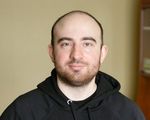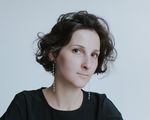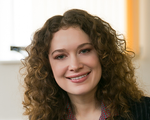About Success Builder
How do you find your place in life? How do you find something to do that both comes naturally to you and makes you happy? The answer is that you have to apply the knowledge you’ve gained from university and from life itself correctly. The Success Builder Project features HSE University graduates who have discovered themselves through an interesting business or an unexpected profession. The protagonists share their experiences and lessons learnt and talk about how they’ve made the most of the opportunities they were given.
As adept at mathematics as HSE MIEM graduate and Twin3D Chief Engineer Nikita Zimenko was, he turned out to be even more inquisitive, with the result that he fell out of love with math and set his sights on digital technologies instead. In this interview with Success Builder, he explained how to conduct research on astromechanics, what 3D animators do with the human body and whether metaverses have a future.
Were you ever a gamer?
I’ve never had a powerful gaming PC or console, so the only way to play was with the really old racing games that can run on an ordinary PC. I spent very little time on games, although racing simulators gave me a love for cars, rather than for the IT field per se. My choice of IT as a profession happened very simply. In high school, I was interested in physics, mathematics and the exact sciences in general, so I enrolled in evening school at the Moscow Institute of Physics and Technology where I studied advanced physics and math.
My social circle consisted of erudite guys interested in technical subjects, and this also prompted me to study physics and technology. However, I came up one point short on my standard exam scores and so I went with my second choice: Applied Mathematics at HSE.
Why HSE?
My friends enrolled in physics and technology schools, but HSE was my top choice. It had always seemed to me like a better setup than other universities; I liked its educational programmes and in-house institutions. HSE is about opportunities. It’s about options for broad development, about connections and culture, and not just about studying and non-stop laboratory research. It’s about a bunch of additional activities, all of which you can take advantage of by choosing completely new educational tracks.
An amazing thing happened to me at HSE.
In my third year, I fell out of love with mathematics, although it was taught extremely well
I tried to get used to it. I had to admit to myself: ‘Nikita, enough already. You just have to accept it’. After I did, everything got easier and my studies even improved, although the first courses were still difficult because there were so many subjects.
What has taken the place of mathematics for you?
To some extent, programming has. But on the other hand, I have become interested in how a business works, how the economic infrastructure and IT processes within a company are built in general. When I was a student, everyone was just starting to talk about how companies were digitalising. I got interested in it also. I plunged into the IT optimisation of business. It got to the point that mathematics was no longer a part of my degree at all. It turns out that at HSE you can change the focus of your studies this radically.
What part did applied mathematics play in your programme?
Actually, the mathematics in our curriculum was of a rather general nature. You could delve into mathematical disciplines as part of your major. We studied a huge number of basic subjects. These included linear algebra, functional analysis — that is now in demand almost everywhere analytics is found — data science, machine learning and similar fields. Along the way, we were given more applied disciplines with a focus on business topics, which helped us understand risk management and risk analytics in general. In addition, we had such subjects as decision making under risk, management theory and queue theory. In this way, we got an economics perspective on what we were doing and how we could use that knowledge in the industry. All this provided an understanding of our future prospects.
Now you are also doing research. What do mathematicians study at HSE?
There were a lot of different research projects. If to recall all the topics that my classmates and fellow students studied, it would make my head spin. Many projects were devoted to machine learning. One of my colleagues even studied orbital astromechanics — which is where they write some kind of programme to calculate the optimal flight path of satellites. One person did research on the correlation between music and mathematics. Someone else studied the physics of images, and another did research on some business or other.
After all, mathematics is everywhere in life, and students have practically no restrictions on the topics they can research. Even an ordinary photo on a mobile phone is pure mathematics. Everything related to technology and a number is an exclusively computational thing, and in order to calculate something, you need a mathematical tool. The main thing is for a student to have the desire. If they have that, they’ll find a direction in which to focus their knowledge.
Does HSE have research advisors for every field of interest?
No matter how quirky the topic is, a suitable professor will always be found. In my third year, we had an interdisciplinary term paper. I was fascinated by physics at the time and, as a result, I did my paper on ‘The physical and mechanical properties of the flow of liquid drops in limited geometry’. This was a very applied topic — nothing strange about it at all. Its basic application is industrial laser printers where you need to print information. This is very non-trivial research because it is very difficult to accurately predict the behaviour of microscopic gas or liquid bubbles in a flow of matter. It gets to the point that elements of string theory are woven into the work, although it would seem that string theory has nothing to do with it. My research advisor at the time was Lev Shchur, who gladly supervised my work on this topic.
Have you thought about getting a master’s degree?
When I fell out of love with math, I came to the definite conclusion that I didn’t want to waste my opportunity to get a free master’s education on something that I didn’t like. But what it is I do like, I haven’t decided yet. Plus, I happened to join the ROTC (reserve officer training corps), and only once I completed that and my military rank was assigned was I free to move on. I realised that it would be better to wait a little on the master’s, to get the degree I wanted later rather than to make a hurried and impulsive decision now. Many of my friends who were in a rush to get their master’s degrees later asked themselves why they had bothered. I didn’t want to get burnt out, so I decided to try working first and to figure out what I like doing in general.
Did you manage to get your career started?
I got lucky with my internship. I wound up in the IT department of Adidas while Russia was hosting the World Cup, which led to many interesting projects that combined different disciplines. I also got lucky regarding my coworkers: they understood that I was a student and didn’t expect too much from me. Rather, they contributed to my education.
I had a pleasant and valuable experience; it’s so cool to do work that you enjoy, get a charge from your job and be sought after by your coworkers
This feeling led me to where I work now.
I started looking for a job in IT that deals with hardware. I wanted to avoid analytics, where you would have to cram numbers into tables and try to sell something to someone. Since childhood, I developed the habit of dealing with hardware. My older brother is also in IT, and given the big age difference between us, as a child, I ended up doing whatever he did, like it or not. It was interesting. The knowledge my brother instilled in me back then is still helping me now.
You were into photography. Did you ever want to do it professionally?
I thought about it, but something stopped me: I didn’t have the hubris to make money from photography. When I got a camera, I liked taking pictures and they turned out well, but I earned no more than 1,500-2,000 from all my photos combined. At the same time, I saw how other photographers were asking for more money for worse photos that they had put through VSCO filters. My friends suggested I go shoot weddings. However, there are two things in life to which I will always say ‘no’. The first is shooting weddings, and the second is working in a bank. In the end, the skills and knowledge I’ve gained from this hobby of mine now help me a lot in my work. After all, everything here is the same, but the scale is 180 times larger.
What does the Twin3D company do?
Imagine a Hollywood blockbuster, a very bloody action movie or thriller. One of the key characters is decapitated and his head rolls to the side in a close-up shot. This image could be drawn by CG artists, or else you would have to film someone in make-up rolling on the ground. All this is very expensive and time-consuming. The easiest way is to bring in the actor and scan him. After that, using 3D reconstruction algorithms, the image is digitised, a detailed model is created, and that can then be animated.
The result is a 3D model that you can do anything with — rip off its head or make it jump or fly or just talk realistically. And there are a huge number of ways such models can be used: in movies, video clips, virtual assistants, games, virtual influencers in social networks, metaverses, NFTs, medicine, tailoring, etc.
In general, the approach to this digitisation and to the creation of models came to us from geodesy and is called photogrammetry. This is when special algorithms stitch together a model of buildings, terrain and other large objects from a bunch of pictures. We have two special 3D scanners for humans: one for size and stature and the other for the face. The first produces a life-size figure. The second scans the head to create a detailed model of the face so that emotions can be added to it. After that, everything is processed and animated so that the model demonstrates lifelike facial expressions.
How did you hire on with this company?
I went to a friend’s place for tea. He used to work atTwin3D and told me that the company needed people who would help do 3D reconstruction and also conduct research in this field. The position involved everything that I liked and could do — photography, programming and research. Feeling confident, I applied for the position and was accepted.
For a time, the company was testing new ways to obtain and process these models, so a person was needed who would study these processes in order to structure them, speed them up and achieve better results. They needed continuity and to modernise the algorithms. I started doing this and successfully continue doing so now.
What are you currently working on?
We are testing photometric stereo, a new approach to creating a more detailed model of the head. We are trying to somehow implement it in our processes. In addition, I’m researching the creation of a new digital infrastructure. I’m effectively building it from scratch so that in the future it would be easy to build on, scale up and use to solve problems that might hypothetically arise. It’s an enormous task and everything is very interesting.
What do you think about life in the metaverses?
Yes, the production of metaverse avatars is one of our areas of expertise. From a business standpoint, this is good money because the metaverse is getting a lot of hype and attention from investors. Now it’s just something new and, as always with everything new, people have a desire to quickly fill an empty niche in order to possibly get the most out of it in the future. In my opinion, this is a phenomenon on which many will earn money and many will lose money. It was the same with NFT at one time.
Something tells me that the metaverse is another commercial bubble, simply because the world will not be ready for an alternative reality for a very long time
In order for everything to function normally, huge computing power is needed along with millions of man-hours of work by artists, designers, 3D artists and dozens of other professionals.
This reminds me of Steven Spielberg’s Ready Player One. So far, the metaverses are just a cool novelty on which, among other things, we make money. Due to the increased attention this topic has received, especially at the suggestion of the well-known co-founder of one social network now banned in Russia, a lot of money is invested in metaverse projects. What’s more, those who invest this money often expect a completely different result than the one that the industry is ready to provide.
And if everyone thinks that we will live in a virtual world right now, in reality it will be more like a pumped-up VRChat, simply because the hardware isn’t ready. We can easily make one, two, five or 20 models with our level of detail and place them in one location. But when this becomes 100 models, then the problems begin. And if there are thousands of them, of course everything will get even worse.
Do you have an avatar?
No, but I do have models of myself — and not just one, because I use my body for experiments as the head of the company’s R&D department. I am also trying to develop my own basic algorithm for assembling models, which will help us create simple models faster so that our customers can receive them as soon as possible and see the preliminary result before leaving the cash register, as they say.
What prospects do you see for yourself?
Compared to all the possible options that exist for personal and career growth, everything I’m doing to develop myself seems completely insignificant. The possibilities are simply enormous, even here at Twin3D. With my experience, I could continue to develop in engineering, go deeper into R&D, work towards systems administration or architecture, or go into animators. I only realised how much I could do after I got here and looked from the inside at everything that happens in the digital industry. I realised that IT is just an untapped mine of professions that is brimming with money and a demand for specialists.
As kids, we’ve all been asked, ‘What do you want to be?’ The most common answer was, ‘I want to be a firefighter, a doctor or an astronaut’. None of us said, ‘I want to become a 3D groomer to make animations of eyelashes on an avatar’. The digital industry has developed extremely rapidly and continues to grow. It’s a shame that I’ve hit my stride in this profession so late: I am already 24 years old. On the other hand, I couldn’t be happier that now I’m surrounded by a wonderful group of people whom I feel comfortable working with and whom I trust. However I continue to develop and grow, I see myself doing it with them.













































































































































